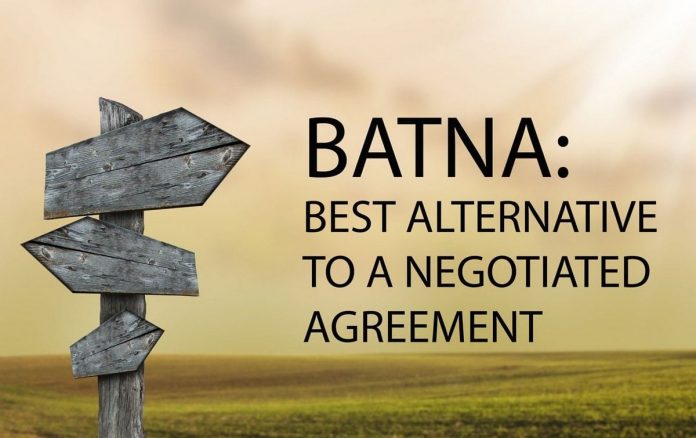This article is written by Tarini Kulkarni, pursuing a Certificate Course in Insolvency and Bankruptcy Code from lawsikho.com.
Table of Contents
Introduction
BATNA stands for ‘Best Alternative to Negotiated Agreement’ and WATNA stands for ‘Worst Alternative to Negotiated Agreement’, first conceived by Roger Fisher and William Ury in 1981. It is a negotiation tool which outlines the course of action to be taken when negotiations fail and no agreement is concluded between parties. If utilised correctly, it can be a strong negotiation tactic resulting in increased bargaining power.
A BATNA/WATNA analysis can be used to analyse how beneficial the agreement may be for you. It will assist you in understanding which terms will be favourable and beneficial for your interest, as well as which terms would be detrimental to you. The analysis will aid your negotiation as it will help you understand the best-case scenario and the worst-case scenario. Generally, if the present deal is not as good as the BATNA, it wouldn’t be advisable to accept it.
A strong BATNA would most likely result in more favourable terms for you, while a weak BATNA is more likely to do the opposite. It becomes important to constantly make attempts to improve your BATNA, to increase your bargaining power.
A simple example of BATNA is if someone is buying vegetables from a vendor who is offering them at Rs. 100, however, they know that they can get it for Rs. 90 from another vendor nearby, that information can be used to drive the price down from the original vendor. In such a case, the consumer can take advantage of their BATNA and utilise it to get a cheaper rate.
Determining your BATNA
Although the concept of BATNA is easy to understand, effective execution is tough. In order to give yourself the most bargaining power, the ideal BATNA should be able to be executed without the involvement of the other party. It is important to constantly attempt to improve your BATNA, and at the same time, gauge what the other party’s BATNA would be.
To determine your BATNA, Fisher and Ury sketched out a basic process that can be used–
- Create a list of steps and actions that can be taken if no agreement is reached.
- Develop the ideas which have more potential so that they become practically viable options.
- Select the options which seem to be the best.
Key points to keep in mind while determining your BATNA–
- The BATNA should be able to be executed without the involvement of the other party– you should be able to execute it on your own with your own resources.
- The BATNA must be achievable keeping in mind all available resources at the time– it must be a real, tangible option which you can actually execute.
- It must be an option that is seen as credible and viable by the other party. It is important that the other party believes that you are willing and able to execute your alternative, else there is a possibility that you will lose out on your bargaining power.
A point to note is that BATNAs are susceptible to change, they are not constant because as time goes on there are many variables which may differ. Information and circumstances can be unpredictable at times and for this reason, it is vital that your BATNA is being constantly revised and updated. This also applies when trying to assess the other party’s BATNA.

BATNAs and the other Side
While analysing your BATNA it is important to also analyse what would be the BATNA of the other party. By doing so, you will be more prepared for the negotiation talks which will be beneficial for you. Gathering as much information on the other side and their options will help you reach a realistic settlement and gauge what offers would be reasonable. Furthermore, it will help you garner a better understanding of the outcomes of the talks.
For example, in the production of the movie, “Analyze This” the production studio wanted to license the use of a song by Tony Bennet. The song was an integral part of the plot and since most of the film had been shot already it was vital for Warner Bros. studios to get the rights to use the song. In such a situation, the knowledge that most of the film had been shot proved to be very beneficial, since there was no alternative to another song being used. By using this information during negotiations, Warner Brothers ended up paying $200,000 for the use of the song, compared to the initial offer of $15,000. Therefore, knowing the BATNA of the other side can help maximise your benefits from the deal. In this case, Tony Bennet knew he had a better BATNA than the studio.
The strength of your BATNA will also determine how much information you relay regarding your BATNA. If you have a strong BATNA you can reveal more information, however if it’s weak you should maintain more secrecy. It is generally advisable to be careful while revealing information at all because one does not know what information the other side is aware of.
BATNAs and the role of third parties
Third parties can assist you in choosing your BATNA by providing practical assistance such as reality testing and costing. This would assist in the assessment of the practicality of the BATNA, and make sure that every question regarding alternatives is answered. This is known as reality testing and it ensures that the ideas on paper can result in fruitful outcomes. Costing is a different method which involves analysing the costs and benefits of each action and outcome. Third parties, therefore, can play a significant role in ensuring that the alternatives become a reality, while also giving a good understanding of all the options available to you.
Why is BATNA important in negotiation
BATNA is an extremely useful tool in negotiation. By analysing your current circumstances and finding the best alternative, you will be able to understand which course of action will be most favourable to your interests and therefore be more prepared. It helps set a benchmark for the kind of outcome that you are looking for and the deal you ultimately agree to should always exceed that benchmark. The comparison between the terms of the agreement and the BATNA helps ensure that your best interest is being kept at a priority.
BATNA should ideally be chalked out prior to the start of negotiations so that you are more prepared when dealing with the other party. By doing this you will have a better understanding of not only the kinds of outcomes possible, but also a set standard which is not overly optimistic or idealistic, but practical in nature because through the BATNA analysis you would have developed a few different ideas which help you understand the range of outcomes that are possible. By keeping this at the forefront during negotiation, you will be able to evaluate how appealing the terms of the agreement being negotiated are. Most experienced negotiators would definitely make sure that they have found the BATNA and use that knowledge to gain leverage during the talks.
A strong BATNA would allow you much more bargaining power if used correctly. The basic principle is that the more the ease with which you can walk away from the table, the more power you have over the discussion, and inevitably, the outcome. Not employing the analysis, you would likely result in you losing out on making a much better deal than if you did use it. In order to ensure that you are getting the best possible outcome, BATNA becomes a valuable tool whose importance cannot be underestimated.
However, it is important to keep in mind that the BATNA shouldn’t be the only consideration while negotiating terms. A central element of negotiation is compromised. The BATNA serves as a tool to get the best deal possible out of the compromise and enhance the position of your side but there will be situations in which your BATNA is better than the best deal on the table. In those situations, if you always go with the BATNA it can cause a standstill, resulting in the loss of the entire deal. It’s important to be realistic while negotiating and gauge all other factors present by keeping the focal point and purpose of the deal in mind. The walking away from the table strategy is often overused and can lead to a complete breakdown of talks, which would defeat the purpose of negotiation in the first place.
Conclusion
Negotiation, being a widely used concept across fields and industries, can be successful through the use of many kinds of strategies and techniques. BATNA is one of them – a tool which can be utilised skilfully by negotiators to achieve a successful outcome. It provides a parameter for choosing the best option, thereby ensuring maximum benefit. Due to its versatility, it is used for negotiating business deals, politics, as well as international treaties.
However, it must be used carefully and strategically in order to have the most positive effect. The strategy utilised with respect to BATNA often depends on various kinds of factors – the facts, the circumstances, the opposite party, as well as the intentions behind the negotiations, amongst others. The expertise needed to wield the tool in the best way comes with time and experience and often, through trial and error. Therefore it is of paramount importance that there is a rough but well thought out plan chalked out prior to negotiation, keeping in mind all relevant factors through which you also identify your BATNA.
Students of Lawsikho courses regularly produce writing assignments and work on practical exercises as a part of their coursework and develop themselves in real-life practical skill.
LawSikho has created a telegram group for exchanging legal knowledge, referrals and various opportunities. You can click on this link and join:
 Serato DJ Crack 2025Serato DJ PRO Crack
Serato DJ Crack 2025Serato DJ PRO Crack










 Allow notifications
Allow notifications



